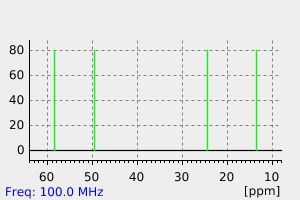1,2-Oxathian-2-oxid | 24308-29-0
中文名称
——
中文别名
——
英文名称
1,2-Oxathian-2-oxid
英文别名
1,2-Oxathiane 2-oxide;oxathiane 2-oxide
CAS
24308-29-0
化学式
C4H8O2S
mdl
——
分子量
120.172
InChiKey
HIBZGXWBEBBKKV-UHFFFAOYSA-N
BEILSTEIN
——
EINECS
——
-
物化性质
-
计算性质
-
ADMET
-
安全信息
-
SDS
-
制备方法与用途
-
上下游信息
-
文献信息
-
表征谱图
-
同类化合物
-
相关功能分类
-
相关结构分类
计算性质
-
辛醇/水分配系数(LogP):0.2
-
重原子数:7
-
可旋转键数:0
-
环数:1.0
-
sp3杂化的碳原子比例:1.0
-
拓扑面积:45.5
-
氢给体数:0
-
氢受体数:3
SDS
反应信息
-
作为反应物:描述:参考文献:名称:Reductive formation of disulfides from sulfenyl, sulfinyl, and sulfonyl derivatives using tri-n-propylamine and trichlorosilane摘要:DOI:10.1021/ja00727a048
-
作为产物:描述:参考文献:名称:An easy preparation of simple sultines and hydroxyalkanesulfinate salts摘要:DOI:10.1016/s0040-4039(00)99119-6
文献信息
-
Protein triggered fluorescence switching of near-infrared emitting nanoparticles for contrast-enhanced imaging作者:Ragini Jetty、Yuriy P. Bandera、Michael A. Daniele、David Hanor、Hsin-I. Hung、Venkat Ramshesh、Megan F. Duperreault、Anna-Liisa Nieminen、John J. Lemasters、Stephen H. FoulgerDOI:10.1039/c3tb20681e日期:——Sub-100 nm colloidal particles which are surface-functionalized with multiple environmentally-sensitive moieties have the potential to combine imaging, early detection, and the treatment of cancer with a single type of long-circulating “nanodevice”. Deep tissue imaging is achievable through the development of particles which are surface-modified with fluorophores that operate in the near-infrared (NIR) spectrum and where the fluorophore's signal can be maximized by “turning-on” the fluorescence only in the targeted tissue. We present a general approach for the synthesis of NIR emitting nanoparticles that exhibit a protein triggered activation/deactivation of the emission. Dispersing the particles into an aqueous solution, such as phosphate buffered saline (PBS), resulted in an aggregation of the hydrophobic fluorophores and a cessation of emission. The emission can be reinstated, or activated, by the conversion of the surface-attached fluorophores from an aggregate to a monomeric species with the addition of an albumin. This activated probe can be deactivated and returned to a quenched state by a simple tryptic digestion of the albumin. The methodology for emission switching offers a path to maximize the signal from the typically weak quantum yield inherent in NIR fluorophores.表面功能化具有多种环境敏感基团的亚100纳米胶体粒子,具有将成像、早期检测与治疗癌症结合在一种长循环"纳米装置"中的潜力。通过开发表面修饰有近红外(NIR)光谱范围内工作的荧光团的粒子,并仅在目标组织中"开启"荧光,可以实现深层组织的成像。我们提出了一种合成NIR发射纳米粒子的通用方法,这些纳米粒子表现出由蛋白质触发的激发/失活。将这些粒子分散在磷酸盐缓冲盐水(PBS)等水溶液中,会导致疏水性荧光团的聚集和发射停止。通过添加白蛋白,将表面附着的荧光团从聚集态转变为单体,可以恢复或激活发射。通过简单的胰蛋白酶消化白蛋白,可以使这种激活的探针失活并返回到淬灭状态。发射开关的方法提供了一条途径,以最大化来自NIR荧光团固有的通常较弱的量子产量的信号。
-
Organic sulfur chemistry. Part XXII. The reaction of sulfinate esters with Grignard and organocopper lithium reagents. A useful route to chiral sulfoxides作者:David N. Harpp、S. Martin Vines、J. P. Montillier、T. H. ChanDOI:10.1021/jo00887a012日期:1976.12
-
King, J. F.; Webster, Michael R.; Chiba, Naoki, Phosphorus and Sulfur and the Related Elements, 1987, vol. 31, p. 161 - 176作者:King, J. F.、Webster, Michael R.、Chiba, Naoki、Allen, Julie K.、Parker, Kenneth J. M.、et al.DOI:——日期:——
-
Cathodic reduction of SO2 in the presence of organic dihalides作者:Dierk KnittelDOI:10.1007/bf00814334日期:1982.1
-
King, J. F.; Rathore, Rajendra, Phosphorus and Sulfur and the Related Elements, 1987, vol. 33, p. 165 - 172作者:King, J. F.、Rathore, RajendraDOI:——日期:——
表征谱图
-
氢谱1HNMR
-
质谱MS
-
碳谱13CNMR
-
红外IR
-
拉曼Raman
-
峰位数据
-
峰位匹配
-
表征信息
同类化合物
硫代羟基乙酸酐
二乙氧基-(1,4-恶噻烷-3-基硫基)-硫代膦烷
N,N-二甲基-1-十八烷基胺与1,2-氧杂硫羟基烷-2,2-二氧化物的反应产物
6-异丙基-1,4-恶噻烷-2-酮
5-甲基-3-苯基-2-氧杂-4-硫杂-二环[3.3.1]壬烷
5-异丙基-2-甲基-1,3-氧硫杂环已烷
4,4-二氢-4-亚氨基-1,4-氧硫杂环己烷 4-氧化物
3,4-环氧四氢噻吩-1,1-二氧化物
2-甲基-4-正丙基-1,3-氧硫杂环己烷
2-甲基-1,4-氧硫杂环已烷4,4-二氧化物
2-甲基-1,3-氧硫杂环已烷
2-异丙基-5-甲基-1,3-氧硫杂环已烷
2,6-二甲基-1,4-氧硫杂环己烷
2,6-二甲基-1,3-氧硫杂环已烷
1-甲基-6-氧杂-3-硫杂双环[3.1.0]己烷3,3-二氧化物
1-氧杂-4-硫杂螺[4.5]癸烷-2-甲醇氨基甲酸酯
1,4-氧硫杂环已烷4-氧化物
1,4-恶噻烷-2-酮
1,4-噻烷-1,1-二氧
1,4-噻烷
1,4-丁磺酸内酯
1,3-氧硫杂环已烷
1,2-氧杂硫烷,3,3,4,4,5,5,6,6-八氟-,2,2-二氧化
3-fluoro-1,4-butanesultone
methyl 2,6-anhydro-4-O-benzyl-3-O-methyl-2-thio-β-L-mannopyranoside
2,2,3,3-Tetrafluor-1,4-oxathian
(1R,4S,5R)-4-methyl-6,8-dioxa-3-thiabicyclo[3.2.1]octane
2,2-Dichloro-4-(3,3-dichloro-tetrahydro-furan-2-yloxy)-butyraldehyde
2-propoxymethyl-[1,4]oxathiane 4,4-dioxide
3,7-Dioxa-10-thia <3,3,3> propellan
3,5-Dimethyl-3,5-dichlormethyl-1,4-oxathian
cis-1,5-Dimethyl-3-oxa-7-thiabicyclo<3.3.0>octan
2-(2-Methyl-1-propenyl)-1,3-oxathiolane
Lithium(1+)6,6-dioxo-2-oxa-6lambda6-thiaspiro[3.4]octane-8-carboxylate
5-Methyl-6-methylene-[1,4]oxathian-2-one
(1'R)-2-<1',2'-Dimethyl-1'-hydroxypropyl>hexahydro-4,4,7-trimethyl-4H-1,3-benzoxathiin
2,5-Anhydro-3,4-dehydro-3,4-desoxy-1,6-thioanhydro-D-glucit
(10S,11S)-10,11-Dimethyl-1,9-dioxa-3,7-dithia-cycloundecane-2,8-dithione
(5S,6S)-6-methyl-5-propan-2-yl-1,3-oxathian-4-one
4-Methyl-1,2-oxathian-2-oxid
2-(methylthio)-1,3-oxathiane
2-ethyl-[1,4]oxathiane 4,4-dioxide
5-[(E)-5-iodopent-3-enyl]-1,4-oxathian-2-one
5-Methyl-1,2-oxathian-2-oxid
Xjzsoywhxcrhsd-aoooyvtpsa-
(1'S)-2-<1',2'-Dimethyl-1'-hydroxypropyl>hexahydro-4,4,7-trimethyl-4H-1,3-benzoxathiin
(S)-2-((2R,6S)-4,4-Dioxo-7a-phenylsulfanyl-6-propyl-hexahydro-1,5-dioxa-4λ6-thia-inden-2-yl)-propionic acid methyl ester
6-methyl-8-hydroxymethylimino-3,7-dioxa-9-thiabicyclo<4.3.0>nonane







